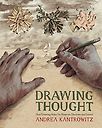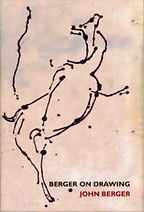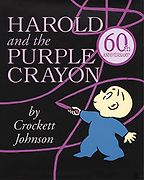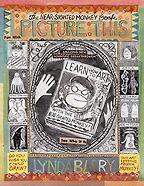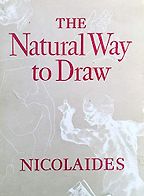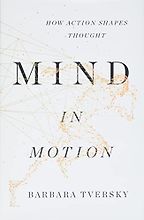Before we get to your selection of drawing books, what do you mean by drawing? And what’s the connection to thinking?
I’m interested in drawing as a process, not so much in finished drawings. Though other people’s drawings can give us insight into their processes of thinking through their subjects and how they use drawing to grapple with and understand whatever they have decided to draw, what interests me is the way the drawer is taken on a journey to discover things about the world, about themselves and their relationship with the world. By that, I mean both the external world and the world inside, which sometimes may feel even more complex than the world outside.
You’re a practitioner. Drawing Thought, your new book, is beautifully illustrated, and I had the occasion to see your work online. Can I ask you, do your paintings also start with drawing? Working through ideas before you apply paint to canvas?
I may sketch my subject on paper before, during, and even after I make a painting, to try to understand certain aspects of the composition or underlying structure. And I draw with the paint, it’s part of the process.
But for me, there’s a big difference between drawing and painting. In the book by John Berger I selected, he describes the difference vividly. Drawing is the journey. The drawing records the actual autobiographical experience of looking and seeing and responding, whereas a painting is an experience that you’re making for someone else, for a viewer. Certainly, in my paintings, I want to take the viewer on a kind of journey through a space that provides opportunities for discovery. And the drawing is the actual experience that the drawer has.
I’m delighted that you chose John Berger’s book of essays on drawing, which—unlike Ways of Seeing—we haven’t featured before. He writes that drawing is as old as song. In his view, there seems to be something almost primordial about it, that it’s central to what it is to be human.
That’s one reason why I’m so fascinated by it as well. It’s like the experience of watching babies start to navigate out the world. It’s amazing that the drawing begins so young. Before they could walk my two daughters were drawing, picking up crayons or markers and just making marks. The fascination and pleasure that they took in that was really revelatory for me. It’s hard to remember for yourself the first time that you made a mark. Watching another person discover that power for the first time was really thrilling. I do believe there is something primal about it.
That’s a lovely segue to Harold and the Purple Crayon, which on the face of it is a children’s book. But perhaps it has important lessons for us as adults, too.
It’s one of the most profound books on drawing that has ever been made. I still have my copy from when I first received it at the age of two or three, with my scribbled annotations on it. The book is really about the way that drawing can take you on a journey that is surprising for the drawer, who is the protagonist with the pencil or crayon in their hand. Drawing itself leads you to places that you would never have gotten to any other way. That’s the story of Harold, which includes several moments where he really gets himself into trouble. He’s lost. The art of getting lost is really valuable. That’s a very significant lesson from this book.
At one point Harold creates a mountain. And then he falls off the edge of the mountain and he’s just floating through space, but he’s got his crayon, so he draws a hot air balloon and safely floats back down to the ground. At another point, he’s hungry, so he makes an apple tree. When it’s time to move on he draws himself a monster to guard the apple tree, but the monster is too scary for him. He has drawn it so well, that his hand starts to tremble with fear. The ripples he makes with the crayon create an ocean and pretty soon he’s over his head in this ocean that he’s created through his own fear. Not to worry though! He comes up thinking fast and draws himself a boat and sails away, making it back to dry land. All of these are such lovely metaphors for how we create problems for ourselves and then solve them. We indulge in the magic of getting lost and eventually trust ourselves to find our way back. Drawing can do that for you!
It’s no surprise that it was called a masterpiece by Maurice Sendak, famed for Where The Wild Things Are. Drawing is a form of problem-solving, of apprehending difficult situations and then processing them, hopefully, to good effect.
Going back to John Berger, I’m reminded of the way he invokes the idea of the mystery of existence. We are sometimes overconfident about our own understanding of the world. Drawing will reveal to us how much we don’t know, the mystery of it all, and that is also a great gift drawing offers us.
Let’s talk about other drawing books. Linda Barry is an Eisner Award-winning graphic novelist. In her book, she asks: What makes kids draw? What makes adults scared to draw? Why is it that we start out just unconsciously drawing?
I don’t think it is unconscious. Children and babies are much deeper thinkers than they’ve been given credit for. Harold is not exceptional in being a brilliant young child, because I think most young children are much more brilliant thinkers than adults often realise.
Maybe I should have said ‘un-selfconsciously’. Linda Barry’s book seems designed almost as an antidote to that kind of adult self-consciousness about drawing.
That’s exactly right. That’s what I love about it. She has suggestions in there to get everybody drawing: just get your pencil moving, just start making dots, doodles. Although at one point she says doodling is a word she doesn’t like for an activity that she loves: just making the marks and seeing what happens, without knowing where it may take you is what matters. Be like Harold: let yourself go on that journey without worrying too much at the outset about where you’re going to end up.
“In order to make a drawing that really communicates the action of the person that you’re drawing from life, you have to feel that action in your own body”
I’ve taught art at all levels, from kindergarten to graduate school. Around third- or fourth-grade children start to get self-conscious, more aware of what others think of them, and that extends to drawing. Some kids get designated as good at drawing. Other children start seeing themselves as people that don’t draw well. Very early on, there’s this idea of ‘good’ and ‘bad’ drawing, and with it comes embarrassment when you do a supposedly ugly drawing as opposed to something good or beautiful. Linda Barry really celebrates the bad drawings, the awkward drawings, as the ones that are really interesting and fun.
There are a lot of how-to drawing books out there for people who want to learn to draw. Or, I suppose, re-learn to draw! Why did you select Nicolaides’ The Natural Way to Draw?
His book, based on his teaching in the 1920s and ’30s at the Art Students’ League in New York City, was really important to me in high school when I was learning how to draw. Much of what I found in subsequent books on the topic—for example Betty Edwards’ Drawing on the Right Side of the Brain—comes straight from Nicolaides. A lot of people who teach drawing today maybe don’t even realise how much of what they teach really comes from Nicolaides, he was so prescient in so many ways.
One of the main messages of his book is that you have to feel what the model is doing. Drawing involves more than looking at the model in some sort of clinical way. In order to make a drawing that really communicates the action of the person that you’re drawing from life, for example, you have to feel that action in your own body.
That idea of sensing action is prescient on so many levels. More recent research in developmental psychology has revealed the way that motor action precedes and facilitates cognitive development. Cognitive scientists today understand cognition as embodied, that thinking is active in the sense that it involves our whole body’s interaction with the world. When we watch an action closely, we’re simulating that action in our minds. Nicolaides understood embodied cognition intuitively, using it as his starting point in teaching drawing. His drawing method built on that understanding on a phenomenological level, before the neuroscience existed. What’s intriguing is that current neuroscience vindicates his view.
Let’s talk about Mind in Motion, then. This book by a very well-regarded psychologist ties in with that idea of embodiment. Marks are a kind of record of thought in space, the body working through that sort of problem-solving element we discussed. Tell us a bit more.
Getting to know Barbara Tversky and her work changed my life. I had been a practicing artist and teaching art in New York City public schools for many years when I went back to school to get a doctorate at Columbia University’s Teachers College. At Columbia, I had the super good fortune to find my way into Barbara Tversky’s cognitive studies doctoral seminar. I was interested in understanding more what is the kind of thinking that art-making facilitates. I focused on drawing, because, as John Berger said, it’s the most basic, primal type of mark-making. I wanted to explore the kind of thinking that drawing specifically enables. Tversky’s work allowed me to place Nicolaides and Berger into context. Her work helped give substance and context to the implications of recent advances in cognitive psychology and neuroscience for understanding the art-making process.
“Visuospatial reasoning underlies all thinking”
In Mind in Motion, Tversky shows that our cognitive processes and our interactions with the world evolved in the context of our need to survive in the world. She illustrates very clearly that the way we navigate as bodies in space is very much fundamental to understanding the way in which we reason and interact with the environments in which we find ourselves. Today, we’re talking about mark-making, art, and drawing, but Tversky relates it to our ways of existing, to social interactions, emotional responses to other people, and even on the level of scientific and philosophical thinking. The scope of the book is astounding.
Five Books interviews are expensive to produce. If you're enjoying this interview, please support us by donating a small amount.
Visuospatial reasoning underlies all thinking; that’s Tversky’s core idea. So much so that we don’t even realise it. In the sentence I just spoke I used two spatial analogies. We talk about the need to put something behind us, or the need to get on top of a situation or balance the scales of justice. All of these described actions are spatial. As a concrete action, drawing allows us to engage with abstract ideas in a really direct way, to visualise non-visible processes.
We’ve talked elsewhere on Five Books about the virtues of an analogue approach to drawing. What are your thoughts about digital forms of mark-making?
In my own practice, I go back and forth constantly. I will do a sketch in my sketchbook and I’ll scan it and manipulate it on the computer, and then maybe I’ll project it back onto a piece of paper and draw it physically, again. But there’s a resistance that you get with physical materials, a kind of feedback that they give you that is really useful, and I don’t think will ever go away. That said, the possibilities for variation and manipulation that you can do digitally are really exciting and fun, allowing you to maybe go to places you couldn’t get to the other way. The digital domain is a kind of infinite space. In fact, it’s a little bit like Harold falling off the edge of a cliff into the void. Sometimes the digital world is so vast, and the space inside the screen is so infinite, that you need to get back to something with physical limitations.
“Draw for half hour. And then take a walk and look around the world, look at your surroundings ”
My digital drawing got a lot better when I got a protective screen cover that has a little bit of friction to it. It slows me down. When you pick up your average stylus and start drawing on a glass screen, it just skitters, there’s no resistance at all. By the same token, the iPad Pro with an angle and pressure-sensitive stylus was absolutely magical when it came out. Still, sometimes I just have to go back to pencil or something really messy. When I was finishing my book I ended up projecting some drawings that I had manipulated digitally onto large pieces of paper and reworked them with charcoal. I redrew them because I just needed that the interaction and resistance of the material.
I love the alternation of text and image in your work, so fitting for the subject matter. In closing, what would be your advice to an adult who has become self-conscious or afraid of drawing?
Just pretend to be a kid. Start scribbling and see what you can discover. Just do it! Honestly, don’t worry about what it will look like in the end. What matters is the experience that you’re having while you’re doing it. Focus on the experience, and if you do that wholeheartedly, the quality of your experience will be evident in the finished drawing. If you’re working from observation, try not to look at your paper. Look at what you’re drawing and try to see it as if you’ve never seen anything like it before.
Get the weekly Five Books newsletter
I recommend going back and forth between drawing from observation and drawing from imagination because the combination will employ two ways of working, complementing each other in a way that makes both more interesting and effective. We use the same parts of our brain when we’re imagining as when we’re looking at something. Strengthening those relationships, especially higher-level processing, comes from using the same parts of our brain to make sense of the visual and spatial world that we’re creating on paper. That can reinforce our capacity to make sense of the visual and spatial world of objects around us. Going back and forth between observation and invention is really valuable.
But just draw. Draw for half hour. And then take a walk and look around the world, look at your surroundings. Notice how much more you are noticing. The most valuable gift the drawing process offers is how it can awaken you, and enrich your lived experience when you are not drawing.
Five Books aims to keep its book recommendations and interviews up to date. If you are the interviewee and would like to update your choice of books (or even just what you say about them) please email us at [email protected]

